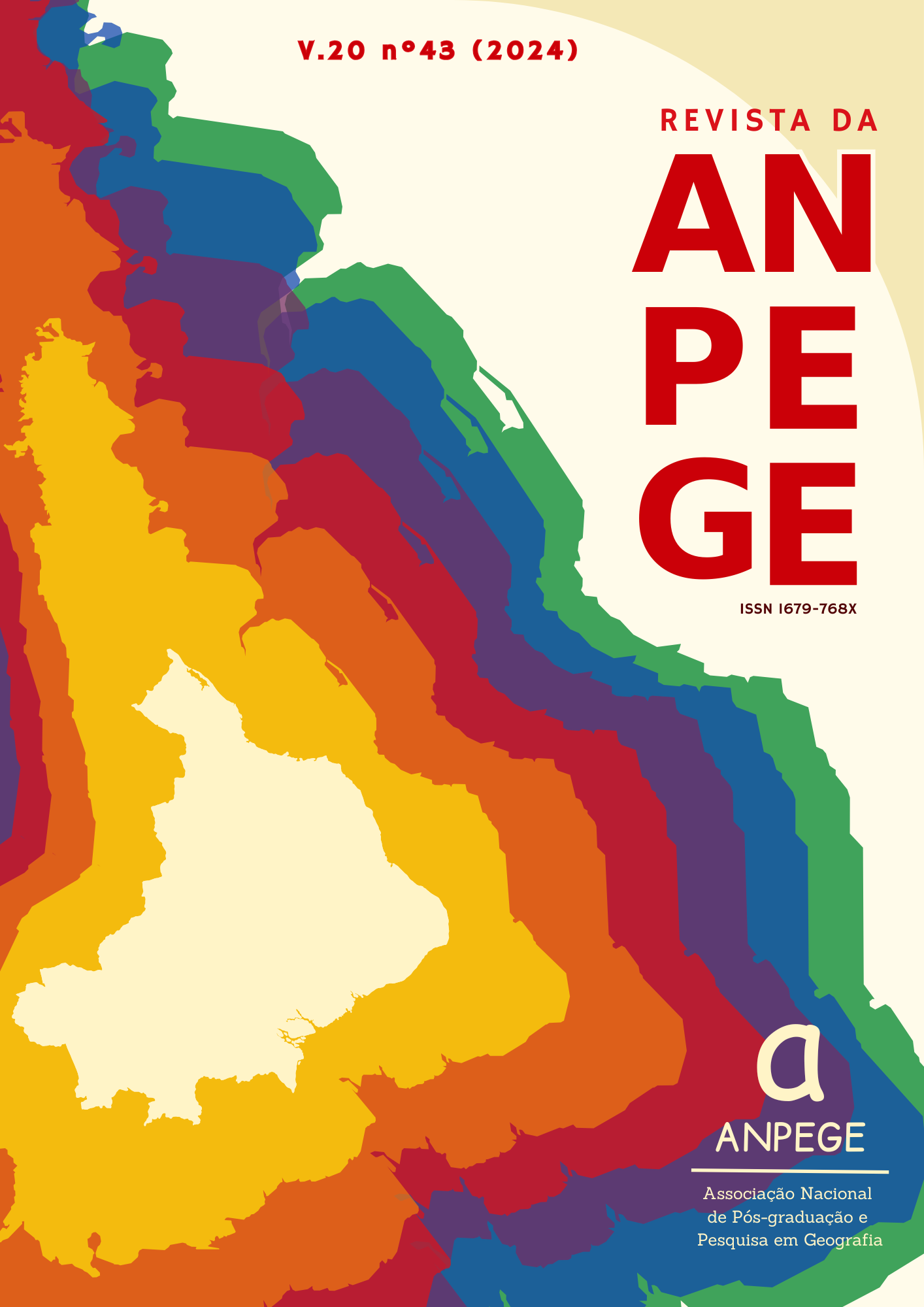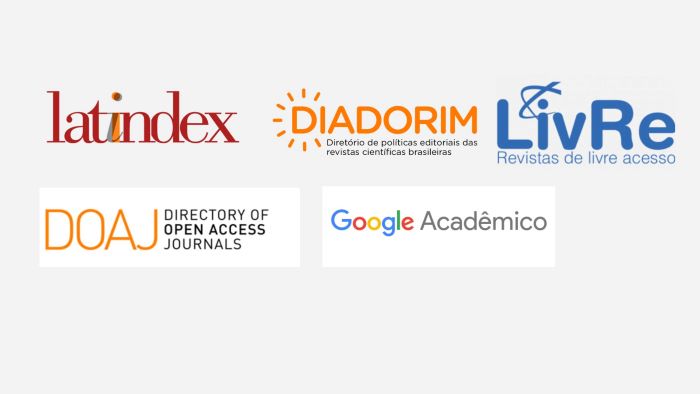Geography of extinctions: deleterious effects of capitalism on brazilian animal biota and its relations with the anthropocene
DOI:
https://doi.org/10.5418/ra2024.v20i43.18783Keywords:
ameaça de extinção, agronegócio, domínios de naturezaAbstract
Based on the hypothesis that capitalist structures implemented in geographic space, especially lands linked to agribusiness, tend to promote landscape homogenization and simplification of biota, this article aims to discuss the current situation of extinction threats in Brazilian territory using mammalian fauna as a bioindicator. The methodological approaches involved the compilation of mammal species threatened with extinction and the identification of their causes, procedures accompanied by related cartographic production, which resulted in a pattern in which the internalization of extinction threats follows the internalization of the Brazilian economy, from the initial economic cycles to the increasingly intensified agribusiness during the Great Accelerations of the Anthropocene, currently responsible for 35% of extinction threat situations in the national territory. The results also showed that the Atlantic tropical forests domain is the one with the highest number of species threatened with extinction due to its environmental history of more intensive occupation, predominantly concentrated in the order Primates, with the spread of the compositional loss of animal biota to the interior of the country.
Downloads
References
AB’SÁBER, A. N. Potencialidades paisagísticas brasileiras. Geomorfologia, n. 55, 28p, 1977.
AB’SÁBER, A. N. Os domínios de natureza no Brasil. São Paulo: Ateliê Editorial, 2003. 159p.
ANGUS, I. Enfrentando o Antropoceno. São Paulo: Boitempo, 2023. 288p.
ANTUNES, A. P.; SHEPARD JUNIOR, G. H.; VENTICINQUE, E. M. O comércio internacional de peles silvestres na Amazônia Brasileira no século XX. Boletim do Museu Paraense Emílio Goeldi, v. 2, n. 2, p. 487-518. 2014. DOI: https://doi.org/10.1590/1981-81222014000200013
BECKER, B; STENNER, C. Um futuro para a Amazônia. São Paulo: Oficina de Textos, 2008. 149p.
CHAZDON, R. L. Renascimento de florestas: regeneração na era do desmatamento. São Paulo: Oficina de Textos, 2016. 430p.
CROSBY, A. W. Imperialismo ecológico: a expansão biológica da Europa 900-1900. São Paulo: Companhia das Letras, 2011. 375p.
ELLIS, E. C. (2020) Anthromes. In: GOLDSTEIN, M.; DELASALLA, D. A. Encyclopedia of world’s biomes. Elsevier: 1-7 DOI: https://doi.org/10.1016/B978-0-12-409548-9.12494-7
FEARNSIDE, P. M. Desmatamento na Amazônia: dinâmica, impactos e controle. Acta Amazônica, v. 36, p. 395-400, 2006. DOI: https://doi.org/10.1590/S0044-59672006000300018
FERRAZ D. da S.; TABACOW, F.; MITTEMEIER, R. A.; MELO, F., BOUBLI, J.; JERUSALYNSKI, L.; TALEBI, M. 2019. Brachyteles hypoxanthus. The IUCN Red List of Threatened Species, 2019. http://dx.doi.org/10.2305/IUCN.UK.2019-2.RLTS.T2994A17927482.en. Acesso em 1232014 DOI: https://doi.org/10.2305/IUCN.UK.2019-2.RLTS.T2994A17927482.en
FONSECA, G. A. B.; RYLANDS, A. B.; COSTA, C. M. R.; MACHADO, R. B.; LEITE, Y. L. R. Livro Vermelho dos Mamíferos Brasileiros Ameaçados de Extinção. Belo Horizonte: Fundação Biodiversitas, 1997. 490p.
GRINEVALD, J.; McNEILL, J.; ORESKES, N.; STEFFEN, W.; SUMMERHAYES, C. P.; ZALASIEWICZ, J. (2019) History of the Anthropocene concept. In: ZALASIEWICZ, J.; WATERS, C. N.; WILLIANS, M.; SUMMERHAYES, C. P. (Eds.) The Antropocene as a geological time unit. Cambridge: Cambridge University Press: 4-11
INSTITUTO CHICO MENDES PARA A CONSERVAÇÃO DA BIODIVERSIDADE. Livro Vermelho das Fauna Brasileira Ameaçada de Extinção. Brasília: UCMBio, 2018. 906p.
KLEIMAN, D. G. (1984) The behavior and conservation of the Golden lion tamarin, Leontopithecus r. rosalia. In: MELLO, M. T. (Ed.) A primatologia no Brasil. Brasília: Sociedade Brasileira de Primatologia: 35-53
MARQUES, L. Capitalismo e colapso ambiental (2° ed.). Campinas: Editora da UNICAMP, 2016. 711p
MARQUES NETO, R. A zoogeografia do Brasil e suas relações com as áreas naturais: uma discussão interescalar a partir da mastofauna neotropical. Revista da ANPEGE, v. 18, n. 37, p. 10-37, 2022. DOI: https://doi.org/10.5418/ra2022.v18i37.14520
McBRIEN, J. Acumulando extinção: catastrofismo planetário no Necroceno (2022) In: MOORE, J. W. (Org.) Antropoceno ou Capitaloceno: natureza, história e a crise do capitalismo. São Paulo: Elefante: 189-219.
MENEZES, D. W. R.; SOUZA, B. I. Antropoceno e História: orbys hypothesis na construção de uma História Ambiental latino-americana. Geousp, v. 27, n. 2, p. 1-24, 2023. DOI: https://doi.org/10.11606/issn.2179-0892.geousp.2023.199891
MOORE, J. W. (2022) Histórias do Capitaloceno. In: MOORE, J. W. (Org.) Antropoceno ou Capitaloceno: natureza, história e a crise do capitalismo. São Paulo: Elefante: 129-186
PAULY. D. 5 Easy pieces: the impact of fisheries on marine systems.Washington D.C: Island Press, 2010. 236p.
PROJETO MAPBIOMAS – Coleção 8 do Mapeamento Anual de Cobertura e Uso da Terra no Brasil entre 1985 a 2022. Acessado em 1162024 através do link: https://brasil.mapbiomas.org/wp-content/uploads/sites/4/2023/09/FACT_port-versao-final.pdf
RIBEIRO, J.; BOURSHEIDT, V. Uso da terra e tendência de dados climatológicos no arco do desmatamento amazônico. Ra’ega, v. 59, p. 59-82, 2024. DOI: https://doi.org/10.5380/raega.v59i0.93241
ROSS, J. L. S. Ecogeografia do Brasil: subsídios para o planejamento ambiental. São Paulo: Oficina de Textos, 2006. 208p.
SAMWAYS, M. Translocating fauna to foreign lands: here comes the Homogenocene. Journal of Insect Conservation, v. 3, p. 65-66, 1999. DOI: https://doi.org/10.1023/A:1017267807870
STERNBERG, H. O. Frentes pioneiras contemporâneas na Amazônia Brasileira: alguns aspectos ecológicos. Inter-facies escritos e documentos, n. 72, 1981. 37p.
TRANCOSO, R. Changing Amazon deforestation patterns: Urgent need to restore command and control policies and market interventions. Environmental Research Letters, v. 16, n. 4, p. 041004, 2021. http://dx.doi.org/10.1088/1748-9326/abee4c. DOI: https://doi.org/10.1088/1748-9326/abee4c
WERNECK, F. P. The diversification of eastern South America open vegetation biomes: historical biogeography and perspectives. Quaternary Science Reviews, v. 30, p. 1630-1648, 2011. DOI: https://doi.org/10.1016/j.quascirev.2011.03.009
Downloads
Published
How to Cite
Issue
Section
License
Autores que publicam nesta revista concordam com os seguintes termos:Autores mantêm os direitos autorais e concedem à revista o direito de primeira publicação, com o trabalho simultaneamente licenciado sob a Creative Commons Atribuição-NãoComercial-CompartilhaIgual 3.0 Brasil que permitindo o compartilhamento do trabalho com reconhecimento da autoria do trabalho e publicação inicial nesta revista.
Autores têm autorização para assumir contratos adicionais separadamente, para distribuição não exclusiva da versão do trabalho publicada nesta revista (ex.: publicar em repositório institucional ou como capítulo de livro), com reconhecimento de autoria e publicação inicial nesta revista.
Autores têm permissão e são estimulados a publicar e distribuir seu trabalho online (ex.: em repositórios institucionais ou na sua página pessoal) a qualquer ponto antes ou durante o processo editorial, já que isso pode gerar alterações produtivas, bem como aumentar o impacto e a citação do trabalho publicado (Veja O Efeito do Acesso Livre em http://opcit.eprints.org/oacitation-biblio.html.)
Authors who publish with this journal agree to the following terms:
Authors retain copyrights and grant the Journal the right of first publication with the work simultaneously licensed under a Creative Commons Atribuição-NãoComercial-CompartilhaIgual 3.0 Brasil that allows others to share the work with an acknowledgement of the work's authorship and initial publication in this Journal.
Authors are permitted to enter into separate, additional contractual arrangements for the non-exclusive distribution of the Journal's published version of the work (e.g., post it to an institutional repository or in a book chapter), with an acknowledgement of authorship and initial publication in this journal.
Authors are permitted and encouraged to publish and share their work online (e.g., in institutional repositories or on their website) prior to and during the submission process, as it can lead to productive exchanges, as well as increase the impact and citation of published work (See The Effect of Open Access - http://opcit.eprints.org/oacitation-biblio.html.)




